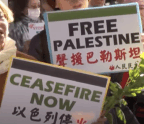Do national parks and wildlife conservation regulations in Nepal benefit Indigenous people?

Originally published on Global Voices

A Chepang residence in Siddi , Chitwan District of southern Nepal. Image by Raajiv Kilana Shrestha via WikiMedia Commons. CC BY-SA 3.0.
Nepal has set an exemplary standard for global wildlife conservation, and its success stories are truly inspiring. Whether it's doubling its tiger population, increasing the forest coverage from 26 to 45 percent in 25 years, or achieving zero poaching of rhinos and tigers in a year, Nepal has achieved many noteworthy conservation goals. However, Indigenous communities such as Chepang, Tharu, Bote, and Majhi people have become the silent victims of Nepal's conservation success story. In 2021, a report jointly released by Amnesty International and the Community Self-Reliance Centre (CSRC) revealed that Nepal's Indigenous communities have endured a series of human rights abuses spanning the last five decades due to oppressive conservation policies.
Nepal's conservation history
Nepal is an incredibly diverse country in terms of geography. Within an area of less than 150,000 square kilometres, its terrain varies from 60 meters to an elevation of 8,848 meters above mean sea level. These diverse terrains contain 118 different types of ecosystems and over 12,000 species of flora and fauna.
Nepal introduced its first wildlife conservation act in 1957. It was replaced by the National Parks and Wildlife Conservation Act in 1973, which provided legal protection to 27 mammal species, nine bird species and three reptile species. Also, in 1973, Nepal established its first National Park — the Chitwan National Park — which was granted World Heritage Site status in 1984.
In 1980, the Department of National Parks and Wildlife Conservation was set up as a separate entity under the Ministry of Forest and Soil Conservation.
To conserve the ecosystems and biodiversity, Nepal now has 12 national parks, a wildlife reserve, a hunting reserve, six conservation areas and 13 buffer zones, covering 23.39 percent of the total land area. According to WWF Nepal, buffer zones are “areas adjacent to national parks or wildlife reserves where wild animals and villagers can co-exist.”

Women from the Subarnapur Buffer Zone go to fetch fodder for their livestock. Image by the author.
Rights violations of Indigenous communities
Indigenous Peoples like Chepang, Musahar, Majhi, Bote, Tharu, who are living in the southern belt of the Terai region buffer zone, have been adversely impacted in their day-to-day livelihood, as well as in their social, cultural, and spiritual practices due to conservation policies, natural resource extraction, and mega-development projects. This has severely limited their ability to access traditional foods, medicinal plants, and other resources.
There have been multiple forced evictions of landless Indigenous peoples living on the periphery of protected areas by park authorities. There were news reports of Chepang families being compelled to leave their homes through arson and incidents where people had their possessions destroyed. These actions represent violations of their constitutional rights, basic fundamental human rights, and housing rights. Illustrating this, a recent statement from a participant in the Tharu community during an event organized by the Center for Indigenous Peoples’ Research and Development (CIPRED) raised concerns, stating, “Indigenous Tharu community people were evicted from the Chitwan National Park area during its establishment period, and now business tycoons are encroaching on the same lands and area.”
For sharecroppers and landless Indigenous communities, damages caused by wildlife, wildlife attacks, and other issues often go unregistered, as they lack land ownership certificates. Consequently, they become ineligible for relief compensation mechanisms.
Amendments to conservation laws
Besides conserving flora and fauna in Nepal, one of the objectives of the Department of National Parks and Wildlife Conservation is to support the communities residing within park boundaries and their buffer zones. However, in reality, Nepal's conservation laws failed to meet international standards, as they currently can only protect people living ‘on land that they own’ and do not ensure adequate safeguards against forced evictions of individuals without ownership titles.
Although Nepal has ratified several international treaties and conventions, the absence of in-house Indigenous Peoples-friendly acts and regulations continues to exacerbate the issue. Neither the outdated National Park and Wildlife Conservation (NPWC) Act (1973) nor the ongoing amendments to regulations, directives, and procedures are inclusive of Indigenous people. The government authority permits the construction of hydropower projects in conservation areas under the guise of National Priority Projects in current regulations. The existing laws have also failed to address the demands of Indigenous and local citizens, necessitating timely amendments.
Section 5 of the National Park and Wildlife Conservation Act (1973) restricts hunting, grazing, tree cutting, land cultivation, or forest use and prohibits all construction within a national park or reserve. Communities whose day-to-day livelihoods and traditions depend on nature are now facing challenges arising from Nepal’s legislation, which criminalizes people living in the periphery of national parks. Based on my field visit in November 2023 and discussions with the Rana Tharu Community residing in Padhao village of Kanchanpur District, adjacent to Suklaphanta National Park, the situation of restricted access to natural resources such as fodder, firewood, and basic edible items for the Rana Tharu community remains unchanged.

A home in Padhao Village, one of the settlements that were relocated from Suklaphanta National Park in the Terai of the Far-Western Region, Nepal. Image by the author.
Articles 6 and 15(1) of the ILO Convention 169 (1989) and Articles 29, 31, and 32 of the United Nations Declaration on the Rights of Indigenous Peoples, or UNDRIP (2007), mandate the facilitation of effective consultations with Indigenous peoples and the requirement to obtain their free, prior and informed consent in matters concerning the conservation of protected areas on their ancestral lands. However, upon reviewing Nepal's NPWC Act (1973), it becomes evident that the Act does not contain any provisions explicitly mentioning consent. There is a notable absence of provisions for free and prior informed consent (FPIC) for Indigenous communities, as stipulated in the ILO Convention 169, the Convention on Biological Diversity (both of which Nepal has ratified), and UNDRIP.
In December 2023, the Center for Indigenous Peoples’ Research and Development (CIPRED) published a common position paper developed in consultation with 23 representatives from Indigenous Peoples and Local Communities organizations. The paper outlines what the Nepal government needs to do and how conservation can be made more friendly to Indigenous Peoples and Local Communities. The recommendations derived from the paper include more protection and remedies for the affected Indigenous peoples and recognition of ancestral lands for respective Indigenous peoples and local communities.
Originally published in Global Voices.






